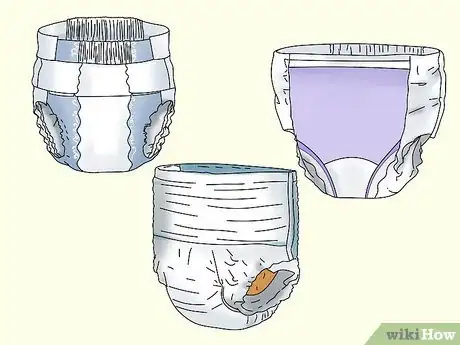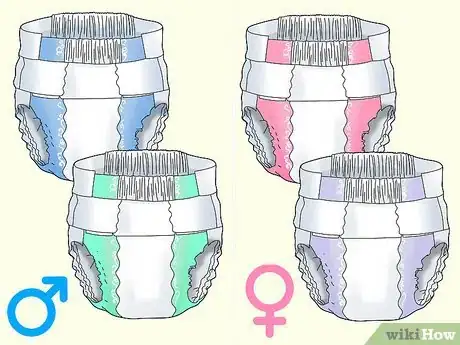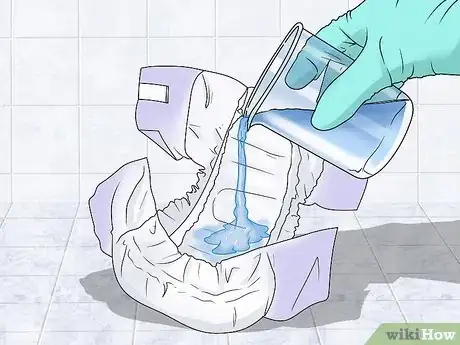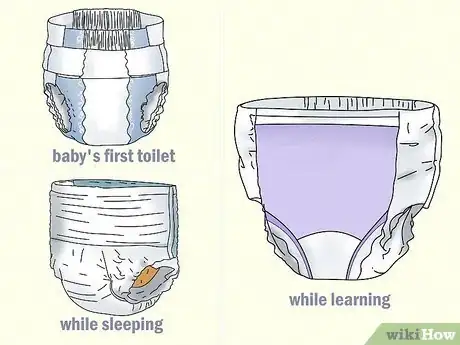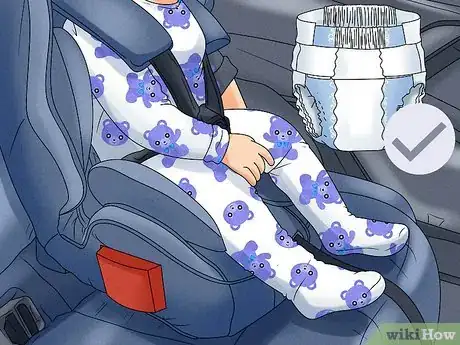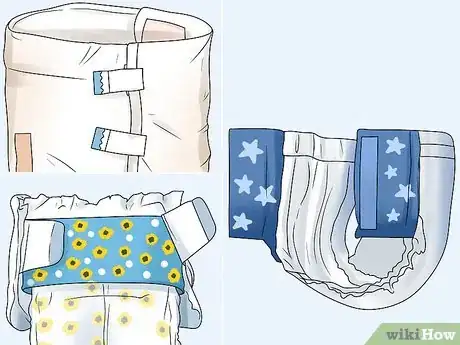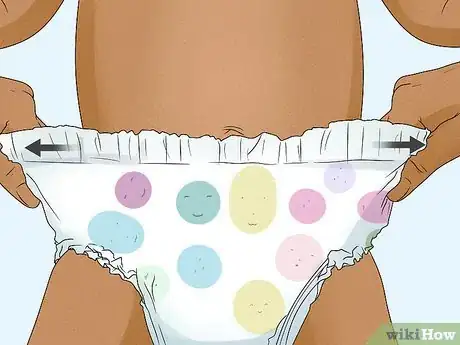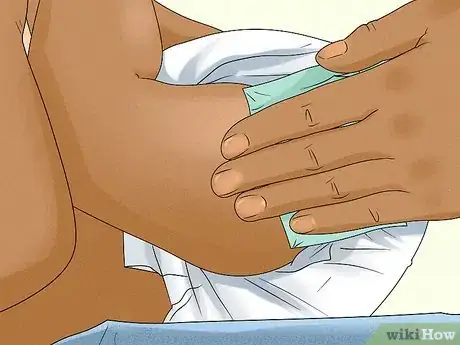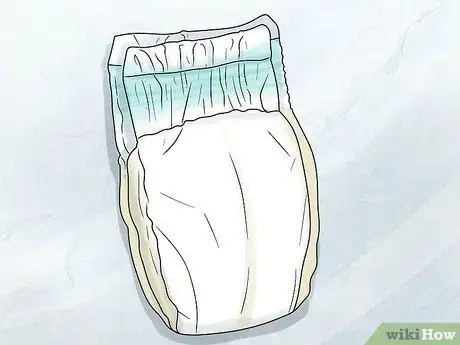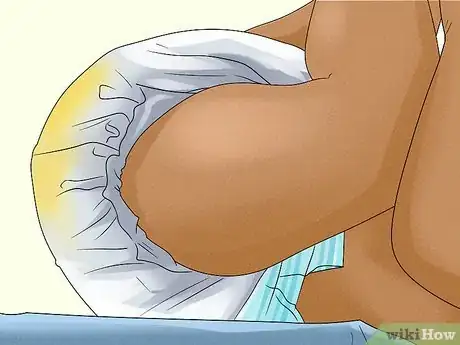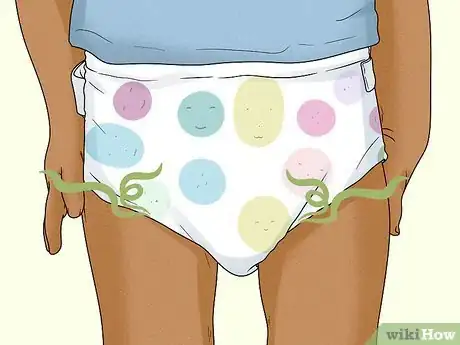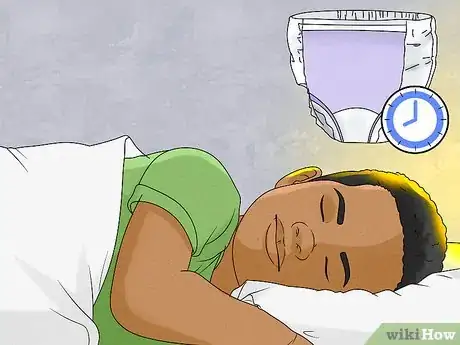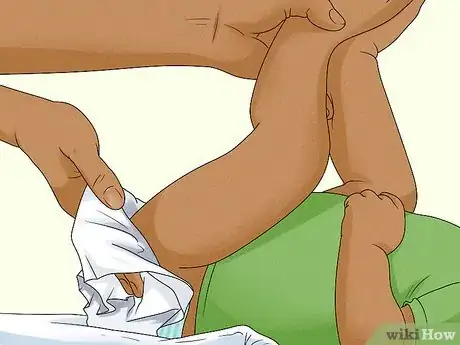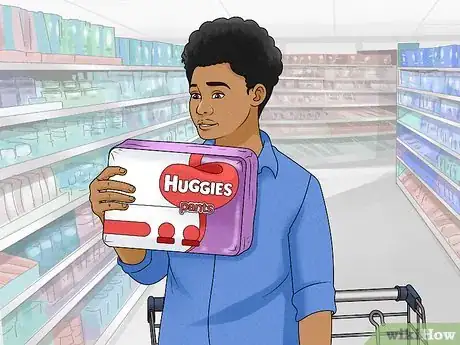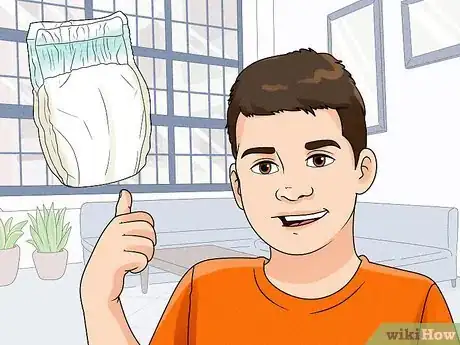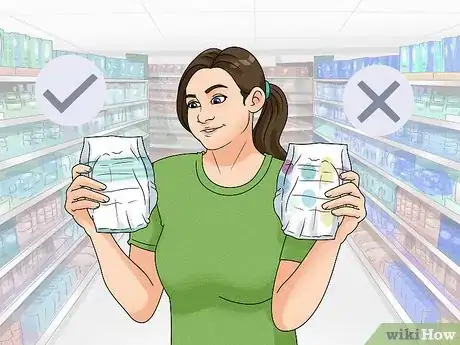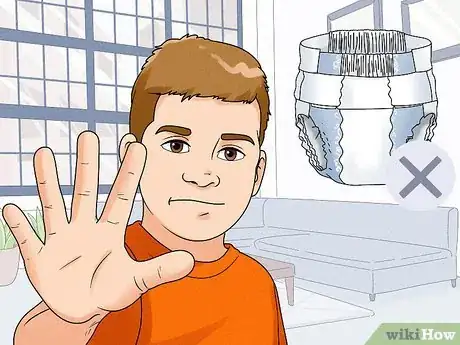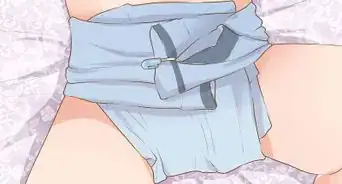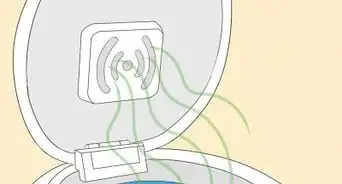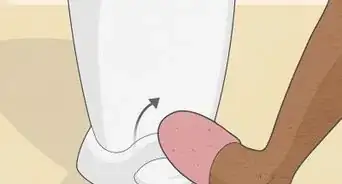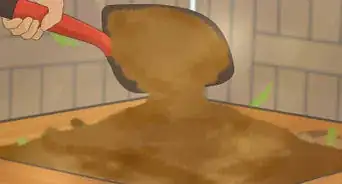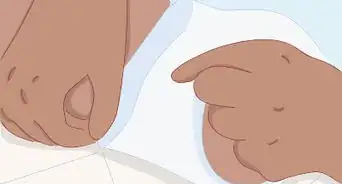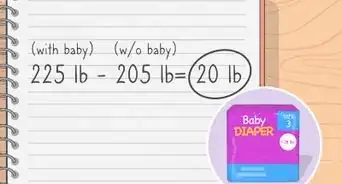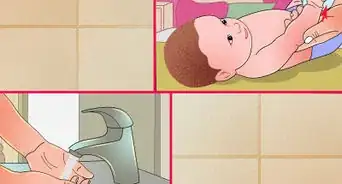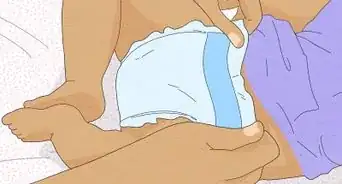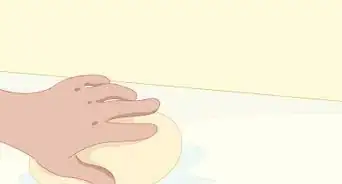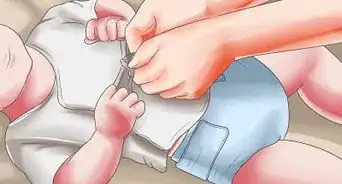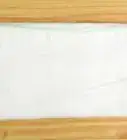X
wikiHow is a “wiki,” similar to Wikipedia, which means that many of our articles are co-written by multiple authors. To create this article, volunteer authors worked to edit and improve it over time.
This article has been viewed 7,838 times.
Learn more...
With so many kids wearing a variety of disposable products available, it's often hard to tell what type of disposable diaper or pant is being used - from a known distance away. This wikiHow will try to clear up whatever confusions between the different products occur.
Steps
Part 1
Part 1 of 3:
Explanatory Notices
-
1Learn about what ages each type of disposable product is meant for.
- Disposable diapers are meant for babies. However, some elementary children (those in kindergarten and first grade) may also covet them for short periods of time.
- Disposable potty-trainer pants are meant for toddlers and some young children primarily between two and four years of age, and some as old as five or six years of age.
- Disposable bedwetting diapers are meant for toddlers and school-age children ages seven to twelve through fourteen. The audience will depend solely on the wearer's ability to wear them due to weight, and all shouldn't be too prolonged, but all need them for extra wetting protection at night.
-
2Experiment with the colors.
- Disposable diapers are mainly white, but all have a graphical strip on their front cover to which the diaper tapes (discussed later) stick to.
- Disposable potty-trainer pants focus on colors set for each wearer's sex. Potty-trainer pants meant for boys will generally be blue or aquamarine in color, while girls' pants will generally see a pink or pastel purple color. Some may have graphical designs printed on them, but in a different spot just below the area once holding the colorful tape-strip.
- Disposable bedwetting diapers are so focused on colors that they have no exterior design; the colors are meant to reflect patterns that look like underwear but contain protective wetting substances instead.
- Packages will often have more stylish design elements than the actual diaper itself.
Advertisement -
3Focus on absorption.
- Disposable diapers are meant for babies and to contain moderate to heavy wetting and "pooping" periods.
- Disposable potty-trainer pants are meant for toddlers who need moderate protection to contain light to moderate messes. These children will often still just be learning about the potty and may suffer from the occasional "mishap" or "accident".
- Disposable bedwetting diapers are meant for more oppressive periods of wetting, for when later nighttime accident-changing times could prolong, and when heavier wetting stages will inevitably be needed by those who can't wake up quick enough to realize they could have the accident right there in bed!
-
4Learn about the primary uses of each disposable product.
- Disposable diapers focus on the "baby's first toilet" concept of the product. Diapers are meant for babies who wet anything and everything in sight because they don't know any different, as they are there to contain all messes being expelled onto or into them.
- Disposable potty-trainer pants focus on the "while learning" concept and are used in hopes for drier days. With the focus on staying dry, the wearer will be training to use the potty/toilet.
- Disposable bedwetting diapers focus on enuresis (or wetting that's happening when the brain isn't active or in a state of "sleep"). It is used so that any wetting that's being expelled isn't soaked into the surrounding surface below the wearer.
- Disposable bedwetting diapers should never be used as part of a regular nighttime diaper regimen as the wearer is daytime potty-trained, and some parents often use a bedwetting diaper as a go-between once the child starts daytime potty-training.
-
5Compare the normal use of the product to the use of the product during travel.
- Disposable diapers make excellent travel tools. Along with routine use around the house, diapers can be carried over into the public's view and can be used anytime the child might wet, or the focus on portability is necessary. However, disposable diapers are often reverted to if the potty-trainer's parents see the need or are traveling for short periods or other "on the run" needs.
- Disposable potty-trainer pants are not meant for travel, but if the parents feel their child has made remarkable progress, they will use the disposable potty-trainer pants and not revert back.
- Disposable bedwetting diapers and travel go hand-in-hand with each other, and their primary function is to be used when the wearer isn't at home. However, they are often tried at home, then tried again while at the others' place (such as for a sleepover or similar).
-
6Focus on the primary brands.
- Disposable diapers are made primarily by Huggies, Pampers, and Luvs. However, other companies such as Honest (which makes natural and chemical-free diapers) and several store brands take the rest of the world's diaper market by storm.
- Disposable potty-trainer pants are put out as either Pampers EasyUps or Huggies Pull-Ups. Store brands exist at some stores, but these focus on smaller-weighted kids and seem to be less strong or see fewer features than the more name-brand varieties.
- Disposable bedwetting diapers are still meant for one sole purpose and, for that, aren't too popular with the younger crowd. Instead, a large selection of them are put out under the Huggies Goodnites and Pampers UnderJams names. The newest addition to the market is the Pampers Ninjanimals, which compares to the weight ranges of the Huggies Goodnites, and some store brands are available but are made for smaller bedwetters only.
-
7Compare the closing methods on each.
- Disposable diapers have refastenable tape-tabs that fasten and unfasten open-to-close for ease of use at each diaper change by the caretaker. Newer diapers for older and more mobile children are now made to fit like potty-training pants with quick fastening (or pull-away) sides, but these can sometimes still be a hassle for parents looking for even quicker diaper changing times.
- Disposable potty-trainer pants have quick-fastening pull-away sides, and some are made to be refastenable. Others have easy-on/easy-off methods that are only convenient to the wearer to undo and redo, but all have rippable sides with or without the special refastenable Velcro strips.
- Disposable bedwetting diapers focus on quick nighttime changes when the wearer shouldn't need to know what's in their diaper and to feel or adjust as necessary. They get pulled up quickly, rip away cleanly, and don't have the Velcro strip or tapes, but aren't refastenable.
Advertisement
Part 2
Part 2 of 3:
Explaining Via Features
-
1Learn about the disposable product's universal fits over both sexes equally.
- Disposable diapers are all made equally. All diaper tabs are meant to close shut the same way, regardless of the sex of the wearer, as these make sure the diaper fits snugly on the wearer while not being too tight. With diapers, there's only one way that diapers are made to secure fit to the wearer.
- Both disposable potty-trainer pants' and bedwetting diapers' fits vary due to the sex of the child, as each childs' genitals are placed in slightly different locations.
-
2See if the product has a stretchy waistband.
- Disposable diapers feature some sort of stretchy waistband, but some come with bigger waistbands than others. Waistbands stretch only when the material is pulled in a certain direction to make a natural fit when the baby moves.
- Disposable potty-trainer pants and disposable bedwetting diapers often have stretchy waistbands that aren't made to stretch very far.
-
3Check for leak guard liners. Leak guard liners are often found at the edges of the core and protect the baby, toddler, or child from their settings near their legs. They are thin elastic "sheets" that should be able to be moved as the wearer's diaper is rustled during and after a wetting. When used, leak guards prevent the mover from traveling and seem to bunch up, spreading the possibility of wetness onto wherever wetness may occur. Leak guards seem non-existent to the wearer, though they are still there.
- Disposable diapers come with these almost by default from almost all diaper companies; however, the need for thickness in the band will depend on the wearer's need. (Example: A newborn's diaper will have leak guards but won't be as elastic as the leak guards of babies wearing the biggest size in the same brand.) Older leak guard liners were thicker but better protected the wearer from any wetting that they did.
- Disposable potty-trainer pants have leak guards, though these aren't as deep as diapers' leak guards, so they don't protect as well.
- Disposable bedwetting diapers use non-flexible leak guards, as they are needed so the wearer won't feel wet when rolling around on the surface at night yet make the diaper feel secure as they move around.
-
4Learn about the presence of an interior soak zone colored pad.
- Disposable diapers for infants don't have any colored interior soak zone pads. However, their diaper's core is the only soaking pad and doesn't differ from other areas outside the wetting surface to those not affected by the wetness.
- Disposable potty-trainer pants often see light-colored bands displaying a special pad to help their beauty stand out in their pants' graphics, yet they aren't seemed to feel any different from other plain-Jane pants.
- Disposable bedwetting diaper wearers, since most often being changed later at night, aren't concerned about the notice of a wetting accident, since the wearer can feel them after the accident happens - close to the skin, and most end up changing near or in mid-darkness anyway - so they will be found to be thrown to the side until they can properly throw them out the next morning.
-
5Learn about the presence of a colored exterior soak zone indicator.
- Disposable diapers for infants don't have them. But the yellower the spot, the denser the "pee" will be, and the more desperate the baby/infant will need to be changed. "Poo" often needs to be smelled to be noticed, though it can be felt as you identify the situation with your fingers going down into the diaper.
- Child-friendly external graphics display on some disposable potty-trainer pants, but not all have this feature. Some rely only on the wearer's feeling of the accident, and so the yellow that was once apparent will often be less noticeable or more faded into the pants' fabric, or which makes it less apparent to their caregiver to notice the problem - until it's overdue or "too late".
- Disposable bedwetting diapers don't focus heavily on the use of external indicators. Most wearers don't care when the wetting happens and won't see it from the outside. Parents/caretakers are left to wonder when the child will come waiting for the diaper or will be left to cry after they notice their diaper has been wetted, or the change is more needed than other times. The yellowing color turns more to a dark color that will depend on the diaper's fabric - if one color-changing strip is available.
-
6Watch how easy it is to identify a used disposable product.
- Disposable diapers for babies don't feature any wetness indicators. Diapers begin to swell as the diaper is used, and along with that, show a bright yellow wetting spot where the wetness is happening, and just shows how badly a change is necessary (or not). (Diapers shouldn't move, and the yellow clogs up in one particular spot.) The urine also smells from ammonia in the diaper's wetting core.
- Disposable potty-trainer pants often have exterior indicators, so the need to change is often easier to identify. However, the smell still emanates when wetting or (sometimes) pooping occurs.
- Disposable bedwetting diapers aren't easy to identify, and only the wearer can sense the used one, purely by the feel of the spot rubbing up against the wearer's skin - all because there are no indicators of any kind.
- For boys, wetness turns to a grey on the diaper's front fabric.
- For girls, you can often see the same area become a slight white or pink color - just a lighter hue than the diaper's material.
-
7Gather the length of time the garment is worn.
- Disposable diapers are always used, up until the child starts potty training or the parents find it necessary to stop using diapers on the child. Each one is changed only as necessary, and typically the only time the child isn't wearing the diaper is when the child is being diaper-changed.
- Once the wearer grows into a toddler and begins potty-training, parents often revert to diaper use at night (to focus only on training during the day) but doctors often say never to revert to diapers during this time. By the time the child moves to elementary school (and may ask to drop or revert to diapers for short periods), the parents may occasionally allow the child to be diapered at set times when their parents agree that the wearer is responsible to come out of the diaper as soon as is prudent enough to stop wearing it so that they can both agree upon its schedule.
- All elementary schools - except those for homeschooled children - are resistant to having a child use diapers as their sole form of underwear during school time, as most fear the school will need to perform periodic diaper changes on each child, tying up the time needed for other children who need the changer more necessarily, and often force the child to begin potty-training with pants or be not accepted to that school until diaper-wearing is complete. If a school-age child is found wearing diapers often, they will often be told to go home and change and once they come back without one, they will be re-admitted.
- Disposable potty-trainer pants are primarily used during the day from the beginning of training and as the child progresses further into potty-training at night, so both you and them can help work together to find a way for them to stay dry.
- Disposable bedwetting diapers are used anytime the wearer's brand is resting or asleep, so they are to be used only during sleep, naps, or "short periods of time" (as expressed by doctors).
- Disposable diapers are always used, up until the child starts potty training or the parents find it necessary to stop using diapers on the child. Each one is changed only as necessary, and typically the only time the child isn't wearing the diaper is when the child is being diaper-changed.
-
8Learn the differences between the changing styles of each of these disposable products.
- With disposable diapers, the name-of-the-game is the side tabs that open and close when the child is laid down in the prone position. For those resistant to such a change, diapers can also be changed standing up, but a wall is needed to hold the diaper and requires more noticeable skin until the diaper is fastened around them from underneath their legs.
- With disposable potty-trainer pants, opening and closing can be a bit tricky. Removal of the pant can be tricky, as these vary by brand (as some come with easy-to-remove/readjust Velcro tapes) and others just rip-off. With security, children are best left standing and end up stepping into the garment, regardless of brand.
- With disposable bedwetting diapers, opening and closing can be a bit tricky, too. Removal, regardless of brand, is made by ripping the sides open. But with securing them, children are best-left standing, stepping into and pulling up the diaper by themselves.
- Some wearers prefer to start the process bedside but resort to finishing the job while standing, or take the diaper to be handled while they lay in the prone position.
-
9Learn where these disposable products can be found.
- Disposable diapers are found inside grocery stores and supermarkets. It's not uncommon to find them, but they sometimes sell out quickly. When big names are sold out, they leave substitute brands behind, including store brand versions or the competition's diaper.
- Disposable potty-trainer pants can also be primarily found in grocery stores and supermarkets. However, while grocery stores mainly stock the store brand, some supermarkets also stock some of the brand name ones, too. (Superstores such as Walmart and Super Target (and similar) will often stock the brand names and their own store brand (on purpose for which only the retailer knows).)
- Disposable bedwetting diapers are found at select retailers. While Walmart and other superstores will stock the brand names, sporadic stocking of even the store brands may happen from time to time at most regional and smaller supermarkets, but it is at the store's discretion what they want to sell at any given time.
Advertisement
Part 3
Part 3 of 3:
Forming Opinions
-
1Learn why parents favor each garment.
- Parents favor disposable diapers over others because of their convenience and universal styling when picking them out at the store.
- Parents favor disposable potty-training pants for their convenience factors after an accident occurs.
- Parents favor disposable bedwetting diapers because of their larger usage factors - factoring back to larger ages and bigger weight ranges.
-
2Learn why children favor each disposable diaper/pant garment.
- Children (or at least those who can express their like for the garment, who may or may not need them) see disposable diapers over others for their comfort and convenience of the product, as well as something that can eliminate stress and excess bodily fluids without doing much cleanup and without taking on the brunt of the diaper changes themselves.
- Children wearing disposable potty-training pants don't choose to say much about why they favor one style over any others. However, for those who do, most say they prefer comfort while learning about toilet use because they couldn't really experience up-close the times while they were in diapers and hadn't been in bedwetting diapers yet.
- Children wearing disposable bedwetting diapers seen convenience in portability and commonality over something they once used (and were deemed "acceptable") and enjoy the ability to use them wherever they need them.
- Most children will be pleased with the intended outcome if things don't take up much valuable time and are changed into equal items (diaper-to-diaper or pant-to-pant).
-
3See why parents dislike each of these disposable products.
- Parents dislike almost all disposable products due to their price tags.
- Some parents of disposable potty-training pants wearers are unaffected by a dislike of feelings, only to a point that these pants are less used and feel that diapers should still be used during the night, while they are training in the daytime - especially early on.
- Some parents disagree in the battle between cloth and disposable diapers because disposable diapers tend to clog up the Earth's clean air in the atmosphere and that they fill up landfills. They often argue to a point that, when they see that there's no "cloth bedwetting diaper", end up giving in when their child complains over the parents' nonuse of any product if it is to be used for a short time.
-
4See why children dislike their disposable products.
- Children who wear diapers and who can talk to a point of explaining their feelings often dislike having time taken away to get their diapers changed.
- Other children dislike them because their genitals are being seen, and they don't want to be put into exposed positions. Most see the laying down method of diaper-changing as being quite babyish to them - even to youngsters as young as two or three years old.
- Some see the babyish feelings of some graphics, while others feel their diapers aren't babyish enough to prefer one over the other.
- Some children who wear Cooling Sensation disposable potty-training pants don't like the cooling sensation of some products, yet also don't like the warm sensations of the wet feelings of their wettened diapers/pants and will do anything and everything in their power to change these feelings.
Advertisement
About This Article
Advertisement
